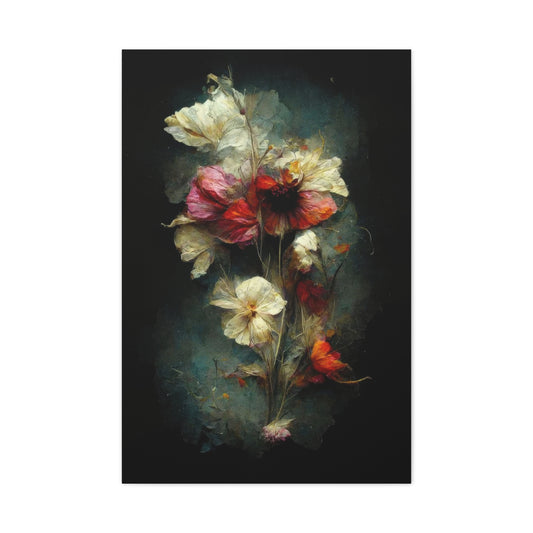Exploring the Extensive Range of White Oil Paints at Gamblin
When it comes to oil painting, white paint is central to any artist's palette. Gamblin Oil Colours takes this to heart by offering a broad spectrum of white oil paints, setting them apart from many other brands that often provide just a few basic options. With a collection of ten distinct white oil paints, each with its characteristics and purposes, Gamblin provides artists with the tools they need to achieve the most refined effects. Whether you're mixing, highlighting, or creating contrasts, these whites play an essential role in making every oil painting a masterpiece. Additionally, Gamblin’s FastMatte White Alkyd Oil Paint introduces an exciting dynamic to their lineup, making it even more versatile for artists seeking various finishes and techniques.
The company recognizes the pivotal role that white paint plays in oil painting. In fact, according to Gamblin, "between half and three-quarters of the paint on most oil paintings is white." This observation resonates with many artists who work with oils, as white paint is more than just a background color. It’s integral in building depth, contrast, and balance in a painting. Though the result may not always be a light or pastel-heavy piece, white remains an essential tool for creating the necessary harmony and structure. Artists use white for many purposes, from lightening vibrant colors to creating highlights, achieving opacity, and even muting overly bright hues. This multifunctional role means that white is often consumed in larger quantities than any other color, making it a vital pigment in any oil artist's toolkit.
The Functionality of White in Oil Painting
The true value of white in oil painting is not just in its appearance but in its ability to modify and enhance other colors. When mixed with other pigments, white can lighten, soften, and even mute tones. It’s the perfect medium for achieving everything from pastel shades to subtle shifts in hue. For instance, white can be mixed with a bright color to create a gentler, less intense version of that hue or can be used to achieve opacity when needed. This interaction between white and other colors is why artists need to understand the specific qualities of different whites, especially within a diverse brand like Gamblin.
With the variety offered by Gamblin, artists are given unparalleled control over the outcome of their work. Each white in their range serves a unique purpose depending on its opacity, texture, and drying time. For example, some whites may allow a more matte finish, while others may add a glossy touch to the final artwork. The ability to choose a white that either complements or contrasts with other colors is a powerful tool for creating depth and complexity in a painting. By mastering how different whites interact with their medium, artists can fully embrace their creative process, achieving nuanced results with precision.
The Variety of Whites in Gamblin’s Lineup and Their Unique Qualities
Gamblin Oil Colours doesn’t just offer the standard Titanium White and Zinc White that many brands carry. They go above and beyond by providing a wider range of options, each designed to suit different artistic needs. With multiple whites to choose from, artists can experiment with various undertones, opacity levels, and drying times, which all contribute to different textures and finishes. This wide range of whites allows for more personalized artistic expression, as each artist can choose the one that best suits their specific technique or desired outcome.
Titanium White, for instance, is known for its bright, opaque qualities, making it perfect for creating highlights and achieving high-contrast effects. However, some artists may prefer a softer, more subtle option like Zinc White, which offers a more translucent and cooler finish. Additionally, Gamblin offers several other whites, each providing unique advantages for different techniques, whether you're working on delicate glazing layers, underpainting, or mixing complex hues. The option to select from a range of whites ensures that artists can tailor their paint choices based on the specific needs of their work.
Notably, Gamblin’s FastMatte White Alkyd Oil Paint introduces a faster-drying option to the mix, giving artists a different way to work with white. This particular formula allows for quicker layering and faster work without sacrificing the quality of the paint or the desired finish. Its rapid drying time makes it ideal for artists who prefer to build up their painting in layers without having to wait for extended periods.
The versatility of Gamblin’s white oil paints isn’t limited to their technical features; it also extends to the creative possibilities they offer. With each variation, artists can adjust the sheen of their paintings, achieving anything from a matte, velvety finish to a high-gloss effect, depending on the project at hand. This flexibility allows for greater experimentation and control, whether the artist is looking for a soft, textured look or a smooth, polished surface.
Furthermore, the range of whites at Gamblin allows artists to explore the effects of light in different conditions. Some whites may appear brighter in natural daylight, while others can absorb more light, creating a muted, more subtle atmosphere. This is particularly important for artists who work with light as a key element in their paintings, as different whites can either enhance or soften the play of light within the artwork. Understanding the differences between each white can help an artist achieve the specific lighting effects they envision.
Gamblin's dedication to providing a wide range of high-quality whites ensures that artists have the right tools to experiment, innovate, and refine their technique. Whether you're an established artist or someone just starting with oil painting, understanding the diverse qualities of white oil paints is an essential part of mastering the medium. With each variety offering distinct advantages, artists can rely on Gamblin’s expertise to select the perfect white that aligns with their vision, ensuring they have the best possible paint to execute their ideas effectively.
Maximizing the Potential of White in Your Oil Paintings
Incorporating white into an oil painting goes beyond just adding light or brightening up a piece. Its role is far more profound and essential to the overall composition of the artwork. White oil paint is frequently used to achieve balance and harmony in a piece by providing areas of contrast and focal points. For example, highlights often feature white as a way to bring attention to certain elements in the painting, such as reflective surfaces, shiny materials, or specific details that demand emphasis. At the same time, the careful use of white can soften the surrounding colors and provide a sense of depth, creating a more nuanced and cohesive piece.
Beyond the technical aspects, the versatility of white paints enables artists to experiment with different techniques and styles. For instance, in glazing, white paint is often used to create thin, transparent layers over the base colors, allowing for a soft, ethereal effect. This can be particularly useful when aiming to create a sense of atmosphere or when layering to achieve depth. In contrast, using white to build up thick, impasto textures can lead to striking, dynamic results that draw the viewer’s eye.
Artists can also use white to control the opacity and transparency of their paint. This is especially important when working with mediums like oils, where layers can become thick and heavy. White can be used to break up the intensity of darker colors, providing a lighter, more breathable texture that doesn't overwhelm the composition. It can even be employed to mute overly saturated hues, ensuring the overall color scheme remains balanced and pleasing to the eye.
The role of white in oil painting extends far beyond just being a tool to lighten colors. It plays a critical role in shaping the structure, tone, and atmosphere of the painting. With Gamblin’s extensive range of white oil paints, artists are empowered to make educated decisions based on their desired outcomes, elevating their work to new heights. The diversity in the options allows for more refined, creative work, ensuring that every artist can find the perfect white to suit their unique style and technique.
By carefully selecting the right white, artists can unlock a greater level of precision and artistic expression, ensuring their oil paintings achieve the depth, texture, and balance they envision. Whether you're a seasoned painter or a newcomer to oil paints, Gamblin’s selection of white oil paints gives you the flexibility and control needed to bring your ideas to life.
The Essential Nature of Titanium White in Oil Painting
Among all the whites available to oil painters, Titanium White stands out as a fundamental and irreplaceable pigment. Celebrated for its incredible opacity and unmatched brightness, this white paint has become a cornerstone in the toolkit of artists across genres. From fine portraiture to expressive abstract work, Titanium White offers both functional benefits and aesthetic power that few other pigments can match.
Its high tinting strength is one of the main reasons Titanium White holds such an important place on the palette. Artists frequently turn to it to lighten dark hues without compromising the integrity of the color mix. When applied over dark backgrounds, it delivers a vivid and striking contrast, amplifying the sense of light and dimension within a painting. Whether you're seeking to intensify highlights or subtly shift the value of a shade, Titanium White offers the reliability and control necessary to achieve precision in tonal transitions.
In brands like Gamblin, Titanium White is formulated to offer excellent coverage, making it not only a dependable mixing white but also an ideal pigment for standalone use. Its density allows it to sit boldly on the canvas, whether used in thick impasto techniques or thinned down for broader applications. As a result, artists find it especially useful in capturing natural light, high-gloss reflections, and dramatic lighting effects.
For oil painters who regularly work in layered compositions or with dark grounds, Titanium White acts as an anchor for the entire painting process. Its brightness cuts through previous layers, offering a clean surface on which to build new forms or reestablish light focal points. In this way, it plays a dual rolenot only enhancing the aesthetic result but also providing practical advantages throughout the painting process.
Versatility in Mixing and the Power of Opacity
Titanium White’s value doesn’t end with its standalone power; its mixing capabilities are where it truly shines. Because of its strong opacity and high refractive index, it serves as an excellent mixing white that allows artists to create a wide spectrum of tints. From subtle pastel shades to vibrant, luminous colors, this pigment is essential for achieving the full range of tonal variation that brings a painting to life.
Painters often depend on Titanium White when crafting delicate highlights or mid-tone transitions. It allows for the rendering of glowing skin tones in portraits, soft morning light in landscapes, or glistening textures in still life compositions. While its brightening effect is powerful, it is also consistent, giving artists confidence in their mixtures and enabling them to replicate color relationships across a painting with accuracy.
Moreover, Titanium White is instrumental in modifying the opacity of more transparent colors. Artists can blend it with transparent pigments to adjust their covering strength, making it easier to mask previous layers or refine the visibility of details. This control over opacity is especially beneficial in layered painting techniques, where certain elements must either stand out prominently or fade subtly into the background.
The usefulness of Titanium White extends into foundational techniques as well. It is a favored choice in underpainting, especially in monochromatic studies such as grisaille. Its ability to create highly opaque layers allows artists to establish form, value, and composition before applying glazes of color. This method provides structure to the final painting and is particularly effective in achieving realism and depth.
Additionally, in contemporary painting practices, Titanium White is often used in textural applications. Artists exploring the physical properties of paint may use this pigment in thick, sculptural forms to play with light and shadow on the canvas. Its dense body supports these techniques, contributing to both visual and tactile experiences in the artwork.
However, despite its many strengths, Titanium White is not without limitations. Its sheer brightness and opacity can sometimes overwhelm more subtle compositions. For artists seeking a softer touch or a more nuanced blend, Titanium White may come across as too stark or overpowering. This is especially true in glazes or situations where transparency is desired to allow underlying hues to show through with delicacy.
Choosing the Right White: Titanium, Zinc, and Beyond
While Titanium White offers a powerful and brilliant tool for most applications, it’s important to recognize that not every painting scenario calls for such intensity. Many artists turn to other whites, such as Zinc White or blends of Zinc and Titanium, to achieve a softer effect. The choice between whites is not just a matter of preference directly impacts the mood, translucency, and structure of a painting.
Zinc White, in contrast to Titanium, is prized for its transparency and delicacy. It is often the white of choice when subtlety is keywhen blending skin tones, glazing over existing paint, or maintaining the vibrancy of mixed colors without overpowering them. Where Titanium White imposes itself with opacity, Zinc White allows colors to breathe, letting underlying layers gently glow through.
For this reason, many artists keep both whites on their palette, using Titanium White for bold highlights and opaque passages, and Zinc White for gentle transitions and transparent glazes. This combination approach allows painters to fine-tune their color interactions and create depth without sacrificing either power or softness.
Furthermore, the advent of pre-mixed whites, such as Titanium-Zinc blends, offers a balanced middle ground. These mixes provide more control over opacity while preserving a level of translucency that pure Titanium White does not. It’s an excellent choice for painters who want some of the strength of Titanium but with added finesse.
Another factor worth considering is the long-term stability of the paint. Titanium White is known for its durability and resistance to yellowing, making it a good option for artworks that must endure the test of time. Zinc White, although beautiful, has sometimes been associated with brittleness and cracking in thicker applications. When planning for archival quality, many artists will use Titanium White for structural elements while limiting the use of Zinc to thin layers or mixed combinations.
The nuanced use of white paints, especially Titanium White, reflects a broader truth that painting is not only about color but also about texture, opacity, and interaction with light. The ability to manipulate these variables through thoughtful pigment selection is what separates technically proficient work from truly expressive and resonant art.
As painting styles evolve and new mediums and supports emerge, Titanium White remains a constant. Whether used in traditional oil painting or mixed media, its presence is almost inevitable for any artist who values control, brightness, and impact. Its role in modern painting is not just historical but active, continuing to shape the way artists conceptualize and execute their work.
In actuality, Titanium White’s unmatched brilliance, coverage, and versatility make it an essential pigment for both beginners and seasoned professionals. Its strength in lightening, covering, and building form elevates the quality of any artwork it touches. While it may not be the solution for every situation, knowing how and when to use Titanium White alongside alternatives like Zinc White empowers artists with greater control and creativity in their practice.
The Delicate Beauty of Zinc White in Oil Painting
Zinc White holds a distinctive place in the world of oil painting, celebrated for its unique properties that set it apart from other whites, particularly Titanium White. Unlike its more opaque and assertive counterpart, Zinc White is subtle, gentle, and transparent, making it a preferred choice for artists seeking refined transitions and nuanced effects in their compositions. This pigment doesn't overwhelm or dominate mixes but instead lends a quiet grace to colors, allowing for intricate blending and layering without compromising the integrity of the hues beneath.
Artists working with Zinc White often discover that its understated nature enhances the emotional tone of a painting. It is especially favored in atmospheric works where mood and subtle lighting play a crucial role. Rather than producing intense brightness, Zinc White contributes to an ethereal light quality. This makes it ideal for capturing fleeting moments, such as the soft glow at dusk, the veil of morning fog, or the diffused light in shaded interiors.
One of the reasons artists return to Zinc White time and again is its seamless ability to mix with other colors. When added to reds, blues, greens, or earth tones, it doesn’t dull them but lifts them gently, preserving their chroma while adding a translucent quality. This characteristic makes it invaluable for refining skin tones in portraiture. When mixed with ochres, siennas, and umbers, Zinc White creates natural, lifelike flesh tones with a softness that mimics real human skin. The pigment’s light touch avoids the chalky or artificial appearance that can result from more opaque whites.
Glazing and Layering: Where Zinc White Truly Shines
Zinc White's transparency unlocks new possibilities for oil painters, especially those who employ traditional techniques like glazing. Glazing involves applying thin, translucent layers of paint over a dry underpainting, allowing each layer to modify the ones beneath. Because Zinc White allows light to pass through it while still subtly tinting the colors below, it is ideally suited for this method.
In the hands of a skilled artist, this pigment becomes a powerful tool for building visual depth and complexity. Whether creating the illusion of shimmering water, reflective surfaces, or translucent fabrics, Zinc White can convey subtleties that opaque whites simply cannot. It does not mask but enhances. This is especially important when depicting delicate phenomena like light bouncing off a misty lake or the play of sunlight on a polished floor.
Moreover, in impressionistic and realist approaches, Zinc White offers artists the flexibility to gently shift tones without overpowering the existing work. It behaves predictably in mixtures and maintains stability in layers, which is critical when constructing multi-layered pieces over extended periods. In glazes, it can lighten colors without erasing their transparency, giving rise to luminous finishes that appear to glow from within.
Painters who work with indirect painting techniques or the Flemish method also find Zinc White indispensable. Its interaction with transparent darks and mid-tones allows for a dynamic interplay of light and shadow, enhancing contrast without adding starkness. The result is a sophisticated visual texture that reads as lifelike and three-dimensional. As layers accumulate, Zinc White helps to create that coveted sense of atmosphere and realism that captivates viewers and draws them deeper into the painted scene.
Limitations, Practical Use, and Choosing the Right White for Your Work
Despite its many advantages, Zinc White does come with limitations that artists should be mindful of. Its transparency, which makes it so valuable for subtle work, can be a drawback when solid coverage is needed. It lacks the robust opacity of Titanium White, which can make it less suitable for bold highlights, heavy impasto, or areas requiring strong visual contrast. If an artist is aiming for brilliant whites or needs to cover dark passages completely, Zinc White alone will not suffice.
In those situations, Titanium White remains the preferred choice. Some artists, however, have found that combining both pigments can yield the best of both worlds: the softness of Zinc White tempered by the strength of Titanium. This hybrid approach allows for flexibility across the painting process, giving artists the ability to tailor their whites to the demands of different passages within a single piece.
Another point to consider is the physical property of Zinc White's brittleness when used in high concentrations or thick layers. Over time, heavy applications can become prone to cracking. This is why it is most often reserved for thin layers or as part of carefully balanced mixtures. Using Zinc White in glazes or lean passages helps avoid these issues while capitalizing on its unique qualities.
Gamblin's Zinc White formulation has received attention for striking a thoughtful balance between tradition and innovation. While maintaining the classic transparency and smoothness artists expect, their version also addresses some of the mechanical challenges historically associated with Zinc White. This modern formulation encourages experimentation while preserving the subtle tonal shifts and harmonious blends that have made Zinc White a staple among experienced painters.
Whether you are painting a mist-covered mountain range, a portrait with delicate skin tones, or the soft transition between light and shadow on a still life, Zinc White offers you a palette of subtle possibilities. It invites patience, rewards precision, and enhances your ability to render light in all its quiet complexity. Artists who are drawn to nuance, transparency, and atmosphere will find in Zinc White not just a color, but a philosophy of painting that values suggestion over assertion and depth over dazzle.
Ultimately, the choice of white pigment depends on your artistic goals. Zinc White excels where delicacy and transparency are essential, opening a world of expressive potential for painters who prioritize softness, refinement, and atmospheric storytelling. Embracing its strengths and acknowledging its limits will help you harness its full potential, allowing your paintings to breathe with subtle life and quiet elegance.
Tinted Whites: Unlocking Precision in Painting
When it comes to achieving exceptional results in painting, the selection of the right white paint can make a significant difference. Gamblin, a well-known name in the art world, offers an impressive range of tinted whites that provide artists with a versatile palette, allowing for a level of precision and detail that enhances the overall composition. While traditional whites like Titanium White and Zinc White are foundational in oil painting, these specialized tinted whites open new possibilities for creating dynamic and harmonious works of art.
Gamblin’s tinted whites are not mere variations of basic white pigments but are carefully crafted mixtures designed for specific artistic needs. Each tinted white offers a subtle yet powerful nuance that enables painters to achieve more refined color harmonies. Whether you are painting a landscape, portrait, or abstract piece, these whites give you the ability to control the temperature and mood of your artwork with finesse.
Warm White: Adding Earthy Depth to Your Artwork
Warm White is one of the standout tinted whites offered by Gamblin. With a slight yellowish undertone, it is specifically formulated to bring warmth to your artwork, making it perfect for capturing the sun-drenched beauty of natural environments. The unique warmth of this white makes it an excellent choice for artists working with earthy tones or for those seeking to evoke a sense of natural light.
One of the primary advantages of Warm White is its ability to blend effortlessly with other warm colors, creating smooth transitions between light and shadow. When used in landscape painting, Warm White is ideal for capturing the reflective qualities of sunlight on natural surfaces such as soil, foliage, or wood. By integrating Warm White into your palette, you can achieve highlights that feel more integrated into the scene, as if they are naturally illuminated by the light source.
In addition to its use in landscapes, Warm White is also a fantastic choice for portraiture, particularly when depicting warm skin tones. Its slight yellowish tint enhances the natural glow of skin, ensuring that highlights on the face or body feel authentic. Whether working with a delicate figure or a complex composition, the warmth of this white can bring a touch of realism and subtle beauty to your work.
Cold White: The Coolness of Shadows and Atmospheric Effects
In contrast to Warm White, Gamblin’s Cold White offers a cooler, bluish undertone that makes it ideal for creating atmospheric effects, adding depth to shadowed areas, and evoking the crispness of colder scenes. Cold White is a must-have for artists who frequently work with snow-covered landscapes, winter scenes, or works that demand a cool, controlled palette. The bluish undertones of this white help capture the reflective light of snow, the subtle chill in the air, and the soft, diffused light found in shadowy regions.
Cold White also excels in portraiture, particularly when capturing the cool, soft light that often appears in the shadows or under certain lighting conditions. By using Cold White, you can add complexity and nuance to your subject, giving it a more atmospheric and ethereal quality. Its cool tone works harmoniously with other cooler pigments, allowing you to create smoother transitions between different light and shadow areas.
Furthermore, Cold White is perfect for creating mood and setting the tone in your artwork. If you are working on a piece where a somber or melancholic atmosphere is desired, the subtle coolness of Cold White can enhance the overall feeling of the painting. Whether you are depicting the stillness of a winter morning or capturing the tranquility of a shadowed interior, this tinted white brings an extra layer of sophistication and emotional depth to your work.
The Role of Tinted Whites in Color Harmony
The role of tinted whites, such as Warm White and Cold White, in color harmony extends far beyond their basic function of lightening other pigments. These whites are nuanced tools in an artist's palette that allow for subtle manipulation of a painting's temperature and tonal structure. Tinted whites can be seen as bridges that help connect disparate elements of color in a cohesive, unified way. The addition of a slight undertone, be it warm or cool, to a neutral white can profoundly affect the mood and aesthetic of a piece. This subtle influence is what makes tinted whites so invaluable for creating balanced color relationships, especially when working with more complex or contrasting color schemes.
Warm White, with its faint yellow undertone, provides a unique opportunity to enrich the warmth of a painting without overwhelming the other hues. It can infuse a sense of sunlight or the glow of a gentle fire, adding a layer of complexity to otherwise flat or muted tones. By introducing Warm White, an artist can gently enhance the vibrancy of cool hues, offering a soft transition between the contrasting colors in the work. This creates a sense of harmony without the harshness that sometimes accompanies the introduction of contrasting colors. The ability to subtly shift the overall temperature of a painting can evoke specific times of day or particular atmospheres, such as the warmth of dawn or the fading glow of twilight.
Conversely, Cold White, with its cooler blue undertone, offers a different set of possibilities. Cold White can be used to desaturate overly warm areas in a painting, giving them a crisp, fresh quality. It can evoke the chill of morning light or the coolness of shade, and its influence on other colors can provide a sense of depth and contrast. Cold White helps to mute intense warm colors, allowing them to recede into the background, while giving prominence to the cooler areas. This ability to adjust the temperature of different sections of the painting not only enhances the realism but also adds emotional depth, as cold hues tend to evoke a sense of calm or detachment. In portraiture, for example, Cold White can be used to accurately render the cool light that falls on the shadowed side of a face, achieving a lifelike representation of light without losing the richness of the skin tones.
The challenge that many artists face when using tinted whites lies in striking the right balance between warm and cool areas of a painting. It requires a thoughtful approach to ensure that neither temperature overwhelms the other, maintaining a natural flow of light and shadow. Tinted whites enable artists to fine-tune their work with more precision, carefully adjusting the color temperature of specific regions to match the desired lighting conditions. This becomes particularly important in portraiture and still life, where the accurate depiction of light and shadow is crucial for realism. The ability to manipulate warm and cool tones gives artists a powerful tool for capturing the complexities of human skin, fabric, or even the texture of a simple piece of fruit, making each element feel three-dimensional and alive.
In portraiture, the use of Warm White and Cold White can transform a painting from a mere representation to a more profound and emotive piece. Skin tones, for example, are rarely a flat, neutral color; they contain variations of warmth and coolness that shift depending on the direction and quality of the light. The careful application of tinted whites can reflect these variations with remarkable precision. By layering Warm White to highlight certain areas of the face, such as the high points of the cheekbones or the nose, the artist can simulate the warmth of natural light hitting the skin. Meanwhile, Cold White can be used in the shadows, where the light is less direct, to simulate the cooler tones found in the depths of the face or under the chin.
Beyond portraiture, the use of tinted whites opens up a world of possibilities for artists seeking to experiment with color theory. These whites are particularly useful for blending different hues in ways that create more dynamic and harmonious transitions between colors. For instance, when mixing colors for a landscape painting, an artist can use Warm White to soften the greens of a meadow, giving the scene a more inviting, sunlit feel. Alternatively, Cold White can be used to cool down the intensity of sky blues, making them feel more atmospheric and distant. In both cases, the tinted whites help control the temperature of the palette, allowing for more refined, controlled transitions between colors.
Artists who work in oil, acrylics, or even watercolor can all benefit from the versatility of tinted whites. The addition of a colored undertone to white paint can help create more nuanced glazes, tints, and layers. Whether used in the mixing process or applied directly to the canvas, these whites act as mediators between the different pigments, allowing for smoother transitions and more natural-looking blends. The effect is one of richness and complexity, elevating the painting beyond a simple assembly of color into a work that feels alive with the interplay of light.
By introducing tinted whites into their creative process, artists gain not only a technical tool for achieving greater precision but also an opportunity to push the boundaries of traditional color mixing. Tinted whites challenge the artist to think more deeply about the temperature and tone of their work, inviting them to experiment with different color harmonies and dynamic compositions. Whether used to warm up cool hues or cool down warm ones, these whites provide an indispensable means for fine-tuning the visual and emotional impact of a painting, opening up a world of creative possibilities that can transform the ordinary into the extraordinary.
More Precision, More Control: Gamblin’s Range of Whites
Gamblin’s range of whites offers artists an impressive selection to choose from, ensuring that no matter the project, there is a white that will suit your needs. From the opaque brilliance of Titanium White to the delicate transparency of Zinc White, and from the warmth of Warm White to the coolness of Cold White, the company’s diverse selection covers a wide spectrum of artistic demands. These whites are designed to give artists more control over their creative process, allowing for greater precision in the execution of their ideas.
Titanium White, for example, is known for its high opacity and is often used when an artist requires a bright, bold white. It is perfect for creating intense highlights and working with vibrant, saturated colors. On the other hand, Zinc White is a more transparent white that can be used for glazing or creating subtle, delicate highlights that blend seamlessly into the painting. Both of these classic whites are essential tools in an artist’s palette, and when combined with Gamblin’s tinted whites, they offer even more flexibility and precision.
By using a combination of different whites, artists can achieve a wide range of effects and tonalities in their work. Whether you're creating a dramatic contrast or working with more subtle shifts in tone, having a variety of whites to choose from allows you to refine your approach and reach the desired outcome more efficiently. This flexibility is crucial for artists who want to push their work to the next level, whether they are working on a small-scale portrait or a large, sweeping landscape.
Conclusion: Mastering the Art of White Selection
Selecting the right white paint is one of the most important decisions an artist can make. Whether you need the opaque brilliance of Titanium White, the delicate transparency of Zinc White, or the subtle nuances of tinted whites like Warm White and Cold White, understanding the unique properties of each option allows you to make informed choices and refine your painting technique. Gamblin’s extensive range of whites provides the flexibility to experiment with different tonalities, temperatures, and textures, giving artists the tools they need to enhance their creative vision.
With tinted whites, artists gain an enhanced level of control over the color temperature and tonal balance of their paintings, allowing them to achieve more nuanced, sophisticated works of art. Whether you're a seasoned professional or an emerging artist, the precision and versatility of these whites can take your paintings to new heights. So next time you reach for a white paint, consider the possibilities that tinted whites offer and discover how they can transform your artwork.
























